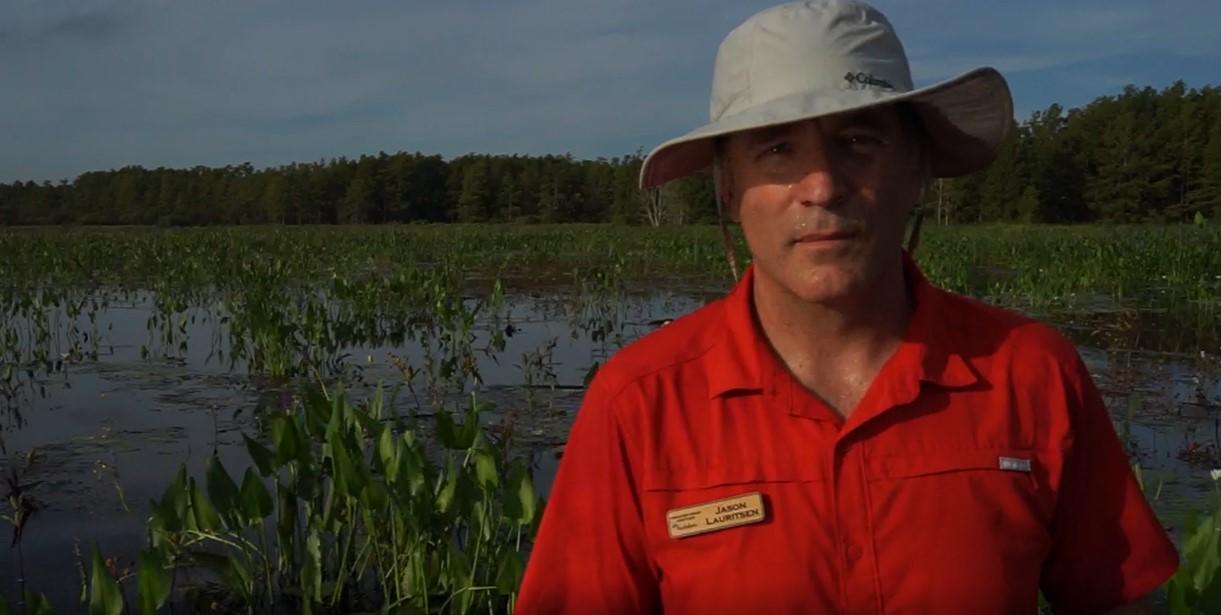September 5, 2018
By Sanctuary Director Jason Lauritsen
The Walk
The insects were already buzzing as I stepped out of the truck and into the marsh to check on the progress of our wetland restoration efforts. The loud clucking I heard came from a group of Limpkins that were expressing their displeasure at my presence. It’s not the first time they’ve scolded me, and it always makes me smile. I love that they are here, and I love that the hunting is good enough for them that they bother to protest the foraging disruption. It is confirmation that our work matters.
I’m entering the 100-acre restoration plot from the northwest corner off of Little Corkscrew Island. Camera and tripod in hand, water now to mid-thigh, I wonder if my cell phone will survive the hike. It did. Another smile, the second of many, appears on my face as a small feathery shape darts from the pickerel weed clump to my right, maybe 10 feet away. Too small for a Common Gallinule, and there were no clucks, my best guess? It was a Sora Rail. They are secretive and I rarely see them. It was the second one I would come across on this trip. My hike also flushed two Green Herons, a Least Bittern and caused a number of Common Gallinules to swim away voicing their irritation. More smiles.
My jeans are soaked, and the dew still clinging to the cordgrass and pickerel weed brushes my shirt and arms, forming little beads that mix with the sweat borne of Florida’s September sun and my exertion. It’s already a great day, and getting better as I survey the marsh.
Three months ago we completed the first phase of this 100-acre restoration effort in Corkscrew’s expansive marsh. Thanks to generous gifts from Coca-Cola and Sea World, we contracted the mechanical removal of dense stands of Carolina willow when the marsh was dry. Exposed to the sunlight for the first time in decades, the seed bank exploded in a mosaic of sedges, grasses and herbaceous flowering plants that comprise a healthy native Florida marsh. As the water rises, it gets too deep for some vegetation, leaving pockets, and ribbons of open water. I gravitate to these, as it is easier walking.
The Fish
My official goal today is to check on the buttonbush (Cephalanthus occidentalis) and take some photos of the progress to help tell the story of our work. On another level, this is pure joy for me. Getting outside, getting into the wild, directly experiencing it, seeing the animals and plants that I labor to save, it doesn’t get much better.
I stop in a patch of still open water to snap a photo. This is a view I want to share. Looking down I realize the water isn’t still after all. Everywhere I look dozens of circles form, disappear, reform all over the surface of the water. I can see lots of small fish darting just below the surface. The water is dark yet clear, tannin-stained like weak tea. I take a peek at the mysterious world below the surface with the help of my waterproof camera.
Mats of periphyton float below water lilies whose leaves form an army of purple pac men, delicate filaments of bladderwort stretch out in the water column, sequestering nutrients and creating a labyrinth of structure that help to hide the mosquitofish, least killifish, sailfin mollies and golden topminnows that we routinely see in these marshes. This is the base of the food chain, critical in supporting our beloved Florida wildlife. The periphyton, plants and fish are here and thriving because we’ve removed the dense canopy of willow that kept this patch in shade for decades. Another key sign of progress.
Plant Community
I’ve already seen enough to know that our efforts last May are bearing fruit.
However, I want to see what is going on with the buttonbush. I wish restoration were a one-and-done endeavor, but it is not. For three to four years following the mechanical removal of the willow, our resource management team has to diligently attend the restoration site, at times carefully applying herbicide to undesirable would-be invasive species to allow the native grasses, sedges and herbaceous flowering plants to establish and thrive, becoming thick enough to eventually support prescribed fires. Though beautiful and native, buttonbush can become one such invader. Two months ago my visit to this plot revealed a large patch of buttonbush, maybe 10 acres in size that had emerged from the seedbank and looked poised to become a dense monoculture not much better than the Carolina willow we just removed. My hope was that water levels would rise fast enough to stress the buttonbush and prevent it from taking over. As I look out, I am relieved to see that the leaves are sparse and show signs of stress. Buttonbush shrubs can reach heights of 12 feet, but these appear to have stopped growing at 3 feet, and the spaces between the shrubs are filling in with a nice mix of herbaceous plants. This is exactly what I had hoped.
On the hike back out the Common Gallinules and Limpkins continue their complaints. I hear Black-bellied Whistling Ducks calling from the general area where I watched two land a few minutes back. More smiles. I’m already looking forward to next time.







